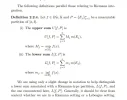- Joined
- 11/5/14
- Messages
- 295
- Points
- 53
Hi guys,
I had taken down some quick summary notes when reviewing stochastic calculus recently, deriving things from first principles and then solving lots of exercise problems from standard sources. Might be helpful for a quick refresher on sell-side math. So, sharing it here.
Cheers.
I had taken down some quick summary notes when reviewing stochastic calculus recently, deriving things from first principles and then solving lots of exercise problems from standard sources. Might be helpful for a quick refresher on sell-side math. So, sharing it here.
Cheers.
